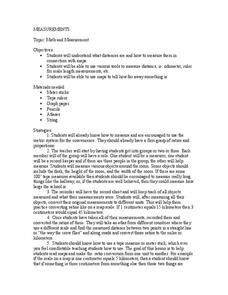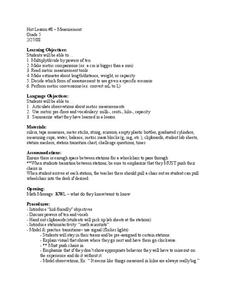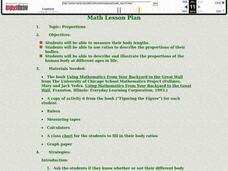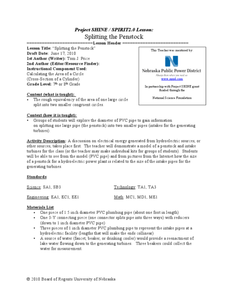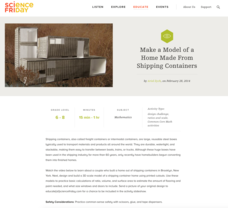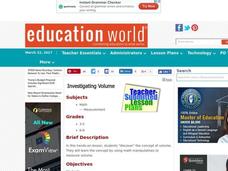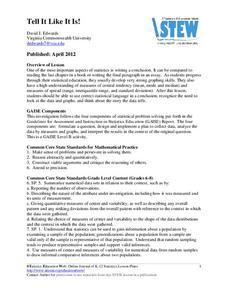Weber State University
The Sun and the Seasons
Why is there more daylight in June than in December if you live above the equator? How does the angle of sunlight shift throughout the year? Answer these questions and more with an interactive article about the sun, its path through the...
Howard Hughes Medical Institute
Virus Explorer
Most pupils know about the flu, HIV, and other viruses, but they don't know what each actually looks like. This interactive shows their relative size, structure, and allows for comparisons. It stresses the similarities and differences...
Curated OER
Math and Measurement
Students use the correct tool to measure distances. In this geometry lesson, students use an odometer and ruler correctly as they study maps. They describe how far way something is.
Curated OER
Making Simple Conversions
Fourth graders explore unit conversions. They create visual models of measurement units, identify tables of equivalent units and make simple conversions with in a measurement system. Students produce charts that identify units of measure...
Curated OER
Scaling Down, Scaling Up
Students understand the meaning of scale and calculate various problems related to Cyberchase videos. In this scaling lesson, students measure a Proporciona boat using blades of grass. Students calculate dimensions based on a scale for...
Curated OER
Measurement
Fifth graders complete measurement problems where they use powers of ten, read metric measurement tools, estimate measurements, and more. In this measurement lesson plan, 5th graders complete 10 problems.
Curated OER
Proportions
Students study proportions. In this mathematics lesson, students measure their body length, head length, and ratio of their body, write their findings on a group chart, and discuss how a person's head size or arm span are in proportion...
Curated OER
The Measurement Web
Second graders review their knowledge of measurement by making a concept web. They write the measurement words on chart paper and discuss them. They use Kidspiration to make the web using the computer. They add new words as they proceed...
Teach Engineering
Weather Basics
Weather — there's more to it than meets the eye of the storm. With this resource young meteorologists learn about the basics of weather, including information about the factors that influence the weather, common weather vocabulary,...
Curated OER
All About Me: Measuring Height and Weight
Students take personal fitness inventories. In this personal health lesson, students take measurements of their heights and weights. Students record the data, calculate their BMI, and then chart their physical activity.
Curated OER
Splitting the Penstock
Students investigate the best way to calculate the measurements of an area. In this geometry lesson, students relate a large circle to a cylinder and its measurements. They use PVC pipes to gain hands on experience as they calculate the...
Edgate
Great Grids
Learners use grid boxes as a measurement tool and discover how grids are used for mapmaking and scaling down an area. They begin by attempting to draw a model shape drawn by the teacher by using the gridding process. At the conclusion of...
Curated OER
Box It Up
Students calculate the surface area of prisms. In this geometry lesson, students investigate the properties of prisms and analyze ways to calculate the are of a rectangular prism. They derive the formula for surface area.
Teach Engineering
Bone Density Challenge Introduction
Can you use X-rays to measure bone mineral density? This is the essential question that learners must answer in the first installment of a seven-part series. They brainstorm ideas about necessary background information and what they...
Science Friday
Make a Model of a Home Made From Shipping Containers
Build a scale model of a home built out of shipping containers. A hands-on activity has scholars watch a video about a home built from shipping containers and then design their own home. They build scale models of their designed homes...
Curated OER
Measure Your Body
Students measure their bodies. In this math lesson, students record their height and weight. Students measure themselves in six months and observe any changes.
Education World
Investigating Volume
Explore the concept of volume using unit cubes. Working individually or in small groups, your class measures with a ruler in inches and calculates the volume of various rectangular household boxes (provided by the teacher) and completes...
Education World
Predicting Pumpkins
If you want more pumpkin seeds, you should get a bigger pumpkin—right? Young harvesters use estimation skills to make a hypothesis about how many seeds they will find in a pumpkin before examining the real number inside.
Utah Education Network (UEN)
The Pasture and the Fence
Beginning geometers use tiles and grid paper to draw and calculate perimeter and area. Rectangles of different sizes are created and then measured to build understanding. The one-inch grid sheet referenced is attached.
Baylor College
Needs of Plants
What better way to learn about plant life than by creating a class garden? Young botanists start with a brief discussion about radishes before planting seeds and watching them grow. To determine the importance of water,...
American Statistical Association
Tell it Like it is!
Scholars apply prior knowledge of statistics to write a conclusion. They summarize using correct academic language and tell the story of the data.
American Statistical Association
EllipSeeIt: Visualizing Strength and Direction of Correlation
Seeing is believing. Given several bivariate data sets, learners make scatter plots using the online SeeIt program to visualize the correlation. To get a more complete picture of the topic, they research their own data set and perform an...
Curated OER
Mapping the Bone Field: An Area and Scale Exercise
Here is an excellent cross-curricular lesson. Learners relate multiplication to area by making a grid on graph paper, and then creating the same grid in real space outside in the school yard.
Curated OER
A Model Solar System
If Earth is modeled by a grapefruit, what planet could be represented by a golf ball? This activity uses everyday and not-so-everyday objects to create a model of the Solar System.


